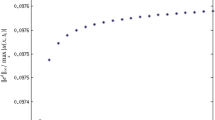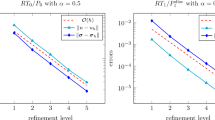Abstract
We develop a monotone finite volume method for the time fractional Fokker-Planck equations and theoretically prove its unconditional stability. We show that the convergence rate of this method is of order 1 in the space and if the space grid becomes suffciently fine, the convergence rate can be improved to order 2. Numerical results are given to support our theoretical findings. One characteristic of our method is that it has monotone property such that it keeps the nonnegativity of some physical variables such as density, concentration, etc.
Similar content being viewed by others
References
Berman A, Plemmons R. Nonnegative Matrices in the Mathematical Sciences. New York: Academic Press, 1979
Cao X, Fu J, Huang H. Numerical method for the time fractional Fokker-Planck equation. Adv Appl Math Mech, 2012, 4: 848–863
Chen S, Liu F, Zhuang P, et al. Finite difference approximations for the fractional Fokker-Planck equation. Appl Math Model, 2009, 33: 256–273
Cottle R, Pang J, Stone R. The Linear Complementarity Problem. New York: Academic Press, 1992
Deng W. Numerical algorithm for the time fractional Fokker-Planck equation. J Comput Phys, 2007, 227: 1510–1522
Fairweather G, Zhang H, Yang X, et al. A backward Euler orthogonal spline collocation method for the time-fractional Fokker-Planck equation. Numer Methods Partial Differential Equations, 2015, 31: 1534–1550
Feng L B, Zhuang P, Liu F, et al. Stability and convergence of a new finite volume method for a two-sided space-fractional diffusion equation. Appl Math Comput, 2015, 257: 52–65
Hejazi H, Moroney T, Liu F. A finite volume method for solving the two-sided time-space fractional advection-dispersion equation. Cent Eur J Phys, 2013, 11: 1275–1283
Hejazi H, Moroney T, Liu F. Stability and convergence of a finite volume method for the space fractional advection- dispersion equation. J Comput Appl Math, 2014, 255: 684–697
Jiang Y. A new analysis of stability and convergence for finite difference schemes solving the time fractional Fokker- Planck equation. Appl Math Model, 2015, 39: 1163–1171
Jiang Y, Ma J. High-order finite element methods for time-fractional partial differential equations. J Comput Appl Math, 2011, 235: 3285–3290
Jiang Y, Ma J. Moving finite element methods for time fractional partial differential equations. Sci China Math, 2013, 56: 1287–1300
Karaa S, Mustapha K, Pani A K. Finite volume element method for two-dimensional fractional subdiffusion problems. IMA J Numer Anal, 2017, 37: 945–964
Langlands T, Henry B. The accuracy and stability of an implicit solution method for the fractional diffusion equation. J Comput Phys, 2005, 205: 719–736
Li X, Xu C. A space-time spectral method for the time fractional diffusion equation. SIAM J Numer Anal, 2009, 47: 2108–2131
Lin Y, Xu C. Finite difference/spectral spproximations for the time-fractional diffusion equation. J Comput Phys, 2007, 225: 1533–1552
Liu F, Zhuang P, Turner I, et al. A new fractionalfinite volume method for solving the fractional diffusion equation. Appl Math Model, 2014, 38: 3871–3878
McLean W, Mustapha K. Convergence analysis of a discontinuous Galerkin method for a sub-diffusion equation. Numer Algorithms, 2009, 5: 69–88
Metzler R, Barkai E, Klafter J. Anomalous diffusion and relaxation close to thermal equilibrium: A fractional Fokker-Planck equation approach. Phys Rev Lett, 1999, 82: 3563–3567
Metzler R, Klafter J. Lévy meets Boltzmann: Strange initial conditions for Brownian and fractional Fokker-Planck equations. Phys A, 2001, 302: 290–296
Mustapha K, McLean M. Piecewise-linear, discontinous Galerkin method for a fractional diffusion equation. Numer Algorithms, 2011, 56: 159–184
Oldham K B, Spanier J. The Fractional Calculus. New York: Academic Press, 1974
Saadatmandi A, Dehghan M, Azizi M. The Sinc-Legendre collocation method for a class of fractional convection- diffusion equations with variable coeffcients. Commun Nonlinear Sci Numer Simul, 2012, 17: 4125–4136
So F, Liu K L. A study of the subdiffusive fractional Fokker-Planck equation of bistable systems. Phys A, 2004, 331: 378–390
Sokolov I M, Blumen A, Klafter J. Linear response in complex systems: CTRW and the fractional Fokker-Planck equations. Phys A, 2001, 302: 268–278
Versteeg H K, Malalasekera W. An Introduction to Computational Fluid Dynamics: The Finite Volume Method. New York: Longman Scientific and Technical, 1995
Vong S, Wang Z. A high order compactfinite difference scheme for time fractional Fokker-Planck equations. Appl Math Lett, 2015, 43: 38–43
Yang Q, Turner I, Moroney T, et al. Afinite volume scheme with preconditioned Lanczos method for two-dimensional space-fractional reaction-diffusion equations. Appl Math Model, 2014, 38: 3755–3762
Zhuang P, Liu F, Anh V, et al. New solution and analytical techniques of the implicit numerical method for the anomalous subdiffusion equation. SIAM J Numer Anal, 2008, 46: 1079–1095
Zhuang P, Liu F, Anh V, et al. Stability and convergence of an implicit numerical method for the non-linear fractional reaction-subdiffusion process. IMA J Numer Math, 2009, 74: 645–667
Acknowledgements
This work was supported by National Natural Science Foundation of China (Grant Nos. 11571053, 11671302, 51239001 and 91647118).
Author information
Authors and Affiliations
Corresponding author
Rights and permissions
About this article
Cite this article
Jiang, Y., Xu, X. A monotone finite volume method for time fractional Fokker-Planck equations. Sci. China Math. 62, 783–794 (2019). https://doi.org/10.1007/s11425-017-9179-x
Received:
Accepted:
Published:
Issue Date:
DOI: https://doi.org/10.1007/s11425-017-9179-x




